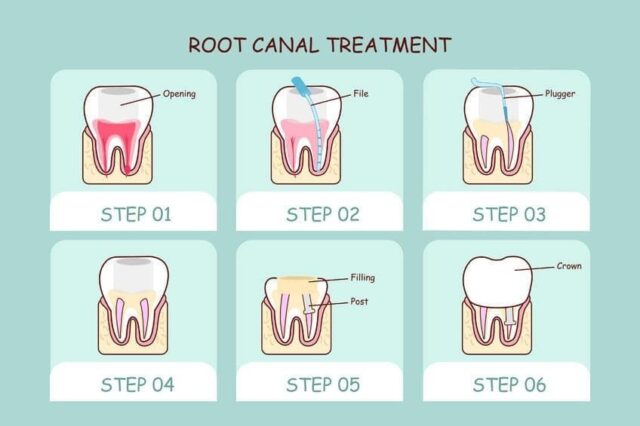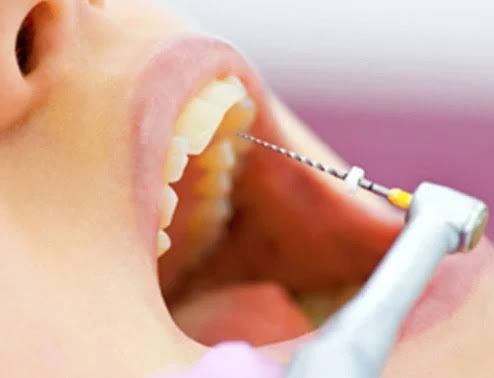If you’ve ever been told you need a root canal treatment (RCT), you’re not alone. Millions of people undergo this common dental procedure every year to save natural teeth and relieve pain. But if you have hypertension (high blood pressure) or diabetes, you might have special concerns. In this blog, we’ll explain what a root canal is, the potential complications for people with these medical conditions, and what to do if something goes wrong.
What Is Root Canal Treatment?
A root canal treatment is a dental procedure used to treat infection or inflammation inside a tooth. The soft tissue inside the tooth — called the pulp — can become infected due to deep decay , cracks , trauma or repeated dental procedures .

MYTHS VS FACTS
- #Myth: You don’t need a root canal if the tooth doesn’t hurt.
Fact: A tooth can need treatment even without pain if infection is present. - #Myth: Root canals require multiple long appointments.
Fact: Many root canals are completed in just one or two visits. - #Myth: After a root canal, the tooth is completely healthy.
Fact: A root-canaled tooth still needs a crown for full protection. - #Myth: Root canal treatment is only for adults.
Fact: Children may also need root canals on baby teeth in certain cases. - #Myth: Root canals remove the roots of the tooth.
Fact: The roots remain; only the infected pulp is removed. - #Myth: You can’t get cavities in a root-canaled tooth.
Fact: The tooth can still decay if not properly cared for. - #Myth: Root canals are not necessary if antibiotics relieve the pain.
Fact: Antibiotics only provide temporary relief; the source of infection must be treated.
What to Do If a Root Canal Goes Wrong
Though most root canals are successful, problems can occasionally arise. Usually root canals take 10 days to heal . It is advised to follow strict protocol as intructed by the doctor of avoiding chewing pressure on that side for around 5-7 days .
But pain persisting even after 15 days of root canal is unusual and should be looked itno seriously . and there might be a chance of root canal failure .
Root canal treatment (RCT) is generally highly successful, with success rates around 85–95%. However, failures can occur due to several factors. Here are the common circumstances in which root canal treatment may fail:
- IMPROPER CLEANING OR SHADPING OF CANALS
- POOR OBTURATION ( FILLING )
- PERSISTANT OR RECURRENT INFECTIONS
- PROCEDURAL ERRORS
- SYSTEMIC OR HOST FACTORS
- TRAUMA
Signs It Might Be Failing:
- Persistent pain after a few days
- Swelling or abscess
- Tooth discoloration
- Bad taste or odor
- Fever or general malaise
Next Steps:
- Contact your dentist immediately — early intervention can prevent complications.
- You may need:
- A repeat root canal (retreatment)
- An apicoectomy (minor surgical cleaning of the root tip)
- In rare cases, tooth extraction
- Follow all post-treatment care instructions, especially if you have hypertension or diabetes.
| Aspect | RCT (Root Canal Treatment) | Re-RCT (Re-Root Canal Treatment) |
| 1. Definition | First-time cleaning and sealing of infected tooth pulp | Retreatment of a previously root-canaled tooth |
| 2. Purpose | To eliminate infection and save the tooth | To fix issues from failed or incomplete initial RCT |
| 3. Complexity | Generally straightforward | More complex due to prior treatment and possible damage |
| 4. Time & Visits | Often 1–2 appointments | May require more visits and longer treatment time |
| 5. Cost | Usually less expensive | Typically more costly due to difficulty and duration |
CONCLUSION
Root Canal Treatment (RCT) remains a highly effective procedure to save teeth affected by deep decay or infection. However, in some cases, initial treatment may not be successful due to factors like missed canals, complex anatomy, or reinfection. In such instances, Re-RCT (retreatment) offers a second chance to preserve the tooth and restore oral health.
Early diagnosis, skilled intervention, and proper follow-up care play crucial roles in the success of both RCT and Re-RCT. If you’re experiencing persistent discomfort in a previously treated tooth, don’t ignore it—timely retreatment may be the key to saving your natural smile.

